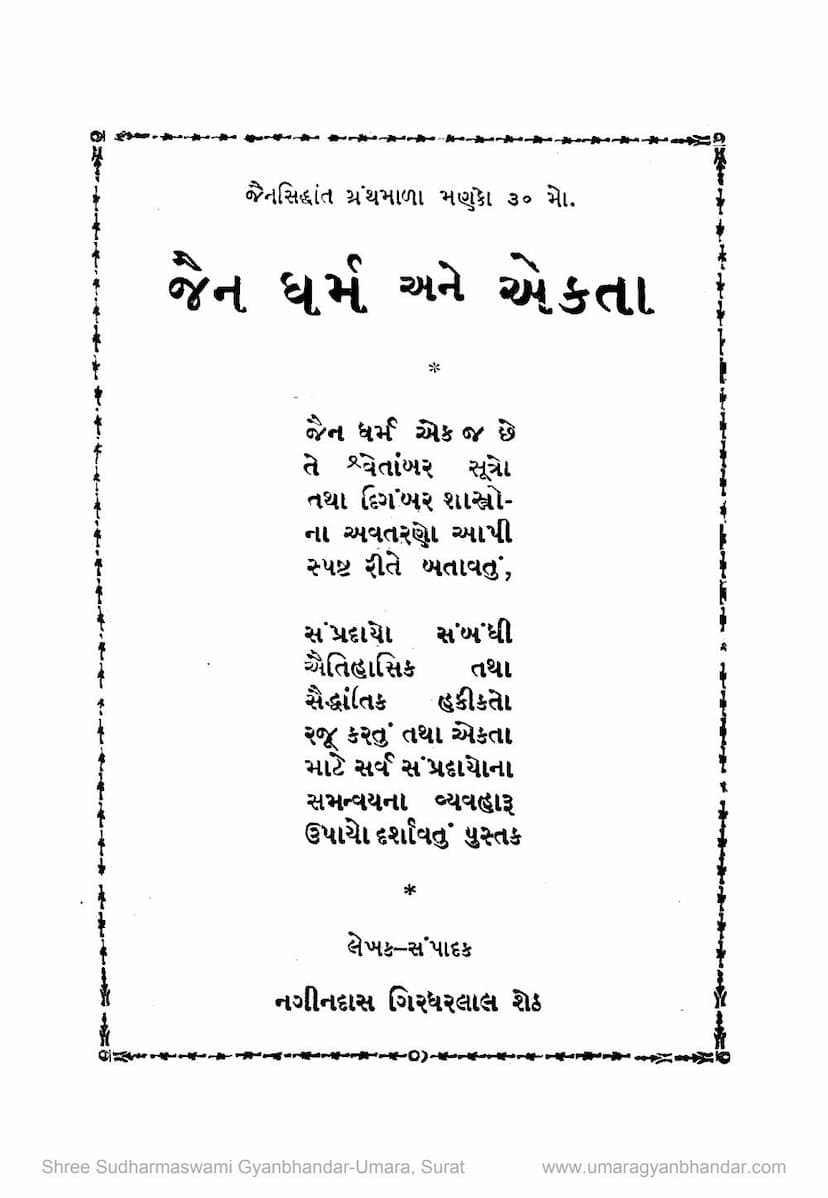Jain Dharm Ane Ekta
Added to library: September 1, 2025

Summary
This book, "Jain Dharm Ane Ekta" (Jainism and Unity) by Nagindas Girdharlal Sheth, published by Jain Siddhant Sabha, argues for the unity of the Jain faith, transcending sectarian differences. The author posits that Jainism, in its essence, is one and will remain so across all time periods, as stated by Lord Mahavir. However, the reality observed is a division into numerous sects, which the author believes contradicts Lord Mahavir's teachings.
The book highlights that while all Jain sects accept Anekantavada (non-absolutism) as the core principle of Jainism, they often resort to Ekantavada (absolutism) to defend their own sectarian views. This, the author contends, shows a misplaced emphasis on their own sectarian pronouncements over those of Lord Mahavir. The text criticizes the practice of labeling followers of other Jain sects as "mithyātvī" (believers in false doctrines), arguing that Lord Mahavir taught that those who do not believe in the Jin, the Nirgranth Guru, and Jainism itself are to be considered "mithyātvī." The author expresses deep concern about the decline of Jainism's influence, noting how it has diminished from a dominant presence in India to a minority religion.
The author attributes the proliferation of sects and their subsequent disagreements to differing interpretations of ritualistic practices (kriyakāṇḍa), while acknowledging that the fundamental Jain principles are universally accepted. He stresses the need for unity and organization in the Jain community, urging a move away from divisive tendencies towards a collective approach, emphasizing the importance of mutual affection among fellow Jains (sādharmī vātsalya). The author calls for cooperation from both lay followers (shravaks and shravikas) and ascetics (tyāgīs, sādhu, and sādhvī), encouraging the latter to abandon divisive preaching and instead promote universal love. The ultimate goal for ascetics, according to the author, should be the propagation of spiritual knowledge and the unification of the Jain community.
The book criticizes the practice of rigidly adhering to specific sectarian beliefs, arguing that it leads to harm and division. It points out that the current era is conducive to achieving unity, and that differences, particularly in ritualistic practices, should not be a cause for division. The author emphasizes that unity is not only possible but essential for the progress and preservation of Jainism.
The book includes a section on practical measures for achieving unity, outlining ten rules. These rules advocate for mutual respect, avoiding criticism of other sects, participation in each other's festivals, listening to each other's teachings, resolving disputes with fraternal affection, avoiding provocative writings or speeches, presenting sectarian views in a balanced manner, and presenting a united front against external challenges. The author concludes by expressing hope that by following these principles, the Jain community can move towards greater unity.
The text also includes a critical analysis of various Jain traditions and their historical development, such as the differences between Śvetāmbara and Digambara sects concerning scriptures, idol worship, and the concept of liberation for women. It delves into the historical context of these divisions, drawing upon various Jain texts and scholarly opinions. The author uses quotes from respected scholars like Pandit Bechardas and Pandit Sukhlalji to support his arguments, while also addressing potential criticisms of their views. The book advocates for a rational and inclusive approach, emphasizing the need to understand the underlying principles rather than rigid adherence to specific interpretations that can lead to sectarianism.
Overall, "Jain Dharm Ane Ekta" is a call to action for the Jain community to overcome internal divisions and work towards a unified and stronger future, grounded in the core principles of Jainism.